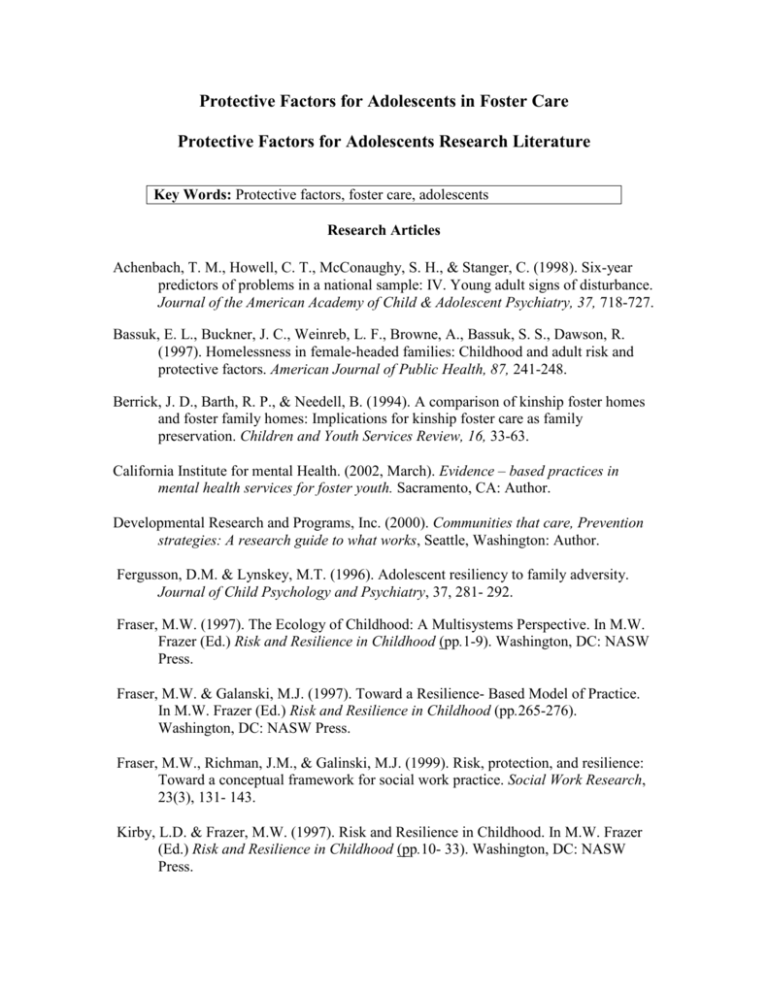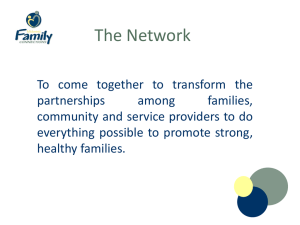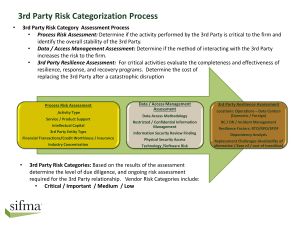Research Articles
advertisement

Protective Factors for Adolescents in Foster Care Protective Factors for Adolescents Research Literature Key Words: Protective factors, foster care, adolescents Research Articles Achenbach, T. M., Howell, C. T., McConaughy, S. H., & Stanger, C. (1998). Six-year predictors of problems in a national sample: IV. Young adult signs of disturbance. Journal of the American Academy of Child & Adolescent Psychiatry, 37, 718-727. Bassuk, E. L., Buckner, J. C., Weinreb, L. F., Browne, A., Bassuk, S. S., Dawson, R. (1997). Homelessness in female-headed families: Childhood and adult risk and protective factors. American Journal of Public Health, 87, 241-248. Berrick, J. D., Barth, R. P., & Needell, B. (1994). A comparison of kinship foster homes and foster family homes: Implications for kinship foster care as family preservation. Children and Youth Services Review, 16, 33-63. California Institute for mental Health. (2002, March). Evidence – based practices in mental health services for foster youth. Sacramento, CA: Author. Developmental Research and Programs, Inc. (2000). Communities that care, Prevention strategies: A research guide to what works, Seattle, Washington: Author. Fergusson, D.M. & Lynskey, M.T. (1996). Adolescent resiliency to family adversity. Journal of Child Psychology and Psychiatry, 37, 281- 292. Fraser, M.W. (1997). The Ecology of Childhood: A Multisystems Perspective. In M.W. Frazer (Ed.) Risk and Resilience in Childhood (pp.1-9). Washington, DC: NASW Press. Fraser, M.W. & Galanski, M.J. (1997). Toward a Resilience- Based Model of Practice. In M.W. Frazer (Ed.) Risk and Resilience in Childhood (pp.265-276). Washington, DC: NASW Press. Fraser, M.W., Richman, J.M., & Galinski, M.J. (1999). Risk, protection, and resilience: Toward a conceptual framework for social work practice. Social Work Research, 23(3), 131- 143. Kirby, L.D. & Frazer, M.W. (1997). Risk and Resilience in Childhood. In M.W. Frazer (Ed.) Risk and Resilience in Childhood (pp.10- 33). Washington, DC: NASW Press. Kraemer, H.C., Stice, E., Kazdin, A., Offord, D. & Kupfer, D. (2001). How do risk factors work together? Mediators, moderators, and independent, overlapping, and proxy risk factors. American Journal of Psychiatry, 158, 848- 856. Lerner, R. M. & Galambos, N. L. (1998). Adolescent development: Challenges and opportunities for research, programs, and policies. Annual Review of Psychology, 49, 413-446. Rak, C.F. & Patterson, L.E. (1996). Promoting resilience in at- risk children. Journal of Counseling & Development, 74, 368- 373. Rutter, M. (1985). Resilience in the face of adversity: Protective factors and resistance to psychiatric disorder. British journal of Psychiatry, 147, 598- 611. Rutter, M. (1987). Psychosocial resilience and protective mechanisms. American Journal of Orthopsychiatry, 57(3), 316- 331. Thorpe, M.B. & Swart, G.T. (1992). Risk and protective factors affecting children in foster care: A pilot study of the role of siblings. Canadian Journal of Psychiatry, 37, 616- 622. Werner, E.E. (1989). High risk children in young adulthood: A longitudinal study from birth to 32 years. American Journal of Orthopsychiatry, 59(1), 72- 81. Citations and Summaries Fraser, M.W., Richman, J.M., & Galinski, M.J. (1999). Risk, protection, and resilience: Toward a conceptual framework for social work practice. Social Work Research, 23(3), 131- 143. Kraemer, H.C., Stice, E., Kazdin, A., Offord, D. & Kupfer, D. (2001). How do risk factors work together? Mediators, moderators, and independent, overlapping, and proxy risk factors. American Journal of Psychiatry, 158, 848- 856. Rutter, M. (1985). Resilience in the face of adversity: Protective factors and resistance to psychiatric disorder. British journal of Psychiatry, 147, 598- 611. Rutter, M. (9187). Psychosocial resilience and protective mechanisms. American Journal of Orthopsychiatry, 57(3), 316- 331. Werner, E.E. (1989). High risk children in young adulthood: A longitudinal study from birth to 32 years. American Journal of Orthopsychiatry, 59(1), 72- 81. CITATION: Fraser, M.W., Richman, J.M., & Galinski, M.J. (1999). Risk, protection, and resilience: Toward a conceptual framework for social work practice. Social Work Research, 23(3), 131- 143. Purpose: Specific aims of this study include: 1. Examination of terminology and definitions used to discuss risk factors, protective factors, and resilience. 2. Review of current literature on this topic area with particular focus on application to Social Work practice. 3. Comparative discussion of how these terms have been operationalized throughout research. 4. Implications for Social Work practice are reviewed and areas for future research are suggested. Risk: The concept of ‘risk factors’ has been used in many different ways in many different fields of study. A clarification and explanation is offered in this article to shed light on how this can be properly framed within the context of Social Work. Risk factors are seen as markers or correlates and often considered causes of behaviors, attitudes, and conditions. Nonspecific risk factors have also been identified at different ecological levels including: individual, familial, and extra familial. While some researchers have identified specific risks, others posit that their cumulative impact is greater and is the bigger problem. Other sections look at assessing risk, how risk is developed, and how it can be viewed in context. Additionally, the authors use empirical studies to illustrate the importance in differences among gender, race, and ethnic groups. Lastly, the risk process is characterized as one that is passive, reactive, reflexive, and has opportunity effects. Protection and Protective Factors: Protective factors are most often used to refer to qualities that predict future outcomes through their ability to moderate, mediate, or compensate for risk. These are not merely the opposites of risk, but should be thought of as separate constructs that effect risk or problem states. In the literature five clusters of protective factors have emerged; they include: characteristic of temperament, skills and values, family support and structure, broader network of support, and the larger opportunity structure. The roles that protection can take on include: compensatory- having a direct effect on a problem, buffering- the degree to which they moderate risk, and cumulativeacting as both a suppressor and buffer to risk. Resilience: This construct is most often viewed as successful functioning in the context of high risk. It connotes unpredicted or markedly successful adaptation to negative life events, trauma, stress, and other forms of risk. This is seen as a particularly difficult concept to measure and is wrought with methodological difficulty. Conclusion: Conclusions based on this review assert that as research and practice become more closely conjoined through evidence based and other practice models, the conceptual framework presented by the risk and resilience perspective has the potential to be an organizing force for the theoretical bases and practice principles informing Social Work intervention. CITATION: Kraemer, H.C., Stice, E., Kazdin, A., Offord, D. & Kupfer, D. (2001). How do risk factors work together? Mediators, moderators, and independent, overlapping, and proxy risk factors. American Journal of Psychiatry, 158, 848856. Purpose: Specific aims of this study include: 1. Examination of methodological basis for investigating how risk factors work in tandem. 2. Review of current empirical approaches based on literature across disciplines. 3. Discussion of how two specific risk factors have been identified as working together to influence an outcome. 4. The suggestion that organization of risk factors can contribute to successful preventative interventions. Methods: Approaches for the study of risk factors from the fields of psychology, epidemiology, clinical trials, and other sciences were collected and synthesized in an attempt to organize and make better use of this approach. Variables: In this study the use of terminology is assessed through an analysis of previous empirical and theoretical literature. Five different and clinically important ways in which two risk factors may work together to influence an outcome have been defined as: mediating, moderating, independent, overlapping, and proxy risk factors. Subjects: The concepts themselves are treated as subjects within the context of this article. The terms that are explored include: risk- the probability of an outcome, correlate- a measure associated with outcome, risk factor- a correlate shown to precede the outcome, causal risk factor- a risk factor that when changed is shown to change the outcome, and confounder- a variable that can cause or prevent an outcome. The authors also find that many researchers use different terms to name the similar concepts, a review and clarification of this is also presented. Results: Conclusions based on this review focus on the need for future research. Specifically, the authors felt that this study would start to bridge gaps between theory, the basic and clinical sciences, and clinical and policy applications for the risk factor perspective. Additionally, an understanding of how risk factors work together is seen as crucial in this field. CITATION: Rutter, M. (1985). Resilience in the face of adversity: Protective factors and resistance to psychiatric disorder. British journal of Psychiatry, 147, 598611. Purpose: Specific aims of this study include: 1. Historical examination of relevant concepts and approaches to research involving resilience. 2. Review of three phases of emphasis in the study of resilience. 3. Discussion of general conclusions that can be reached based on the research to date. 4. The suggestion that the focus of future research should be in the mechanisms that foster resilience. Phases: The first major phase in the study of resilience involved the demonstration that bad experiences did serve to produce or precipitate psychiatric disturbances. This was largely based on the work of Bowlby. The second phase in the study of resilience was marked by researcher’s attempts to provide a better conceptualization of the different types of life experiences. The third phase is seen as the universal observation that even with the most severe stressors and the most glaring adversities; it is unusual for more than half of children to succumb, possibly demonstrating resilience. Concepts: The definitions of the familiar concepts of resilience are reviewed. The terms that are of particular interest in this article involve the constructs of the ‘interactive process’, ‘multiple social adversities’, ‘mechanisms’, ‘timing’, and ‘meaning’. It is thought that these have an important effect on resilience. Results: Conclusions based on this review focus on the need for future research. Of the empirical evidence available at the time of this article, it was felt that explanations for resilience would probably include: the patterning of stresses, individual differences caused by both constitutional and experiential factors, compensating factors outside of the home, the development of self- esteem, the scope and range of available opportunities, an appropriate degree of structure and control, the availability of personal bonds and intimate relationships, and the acquisition of coping skills. Subsequent research has found that this list of contributing factors has been empirically confirmed. CITATION: Rutter, M. (1987). Psychosocial resilience and protective mechanisms. American Journal of Orthopsychiatry, 57(3), 316- 331. Purpose: Specific aims of this study include: 1. Examination of mechanisms that can protect against the psychological risks associated with adversity. 2. Review of how these mechanisms work in relation to the processes of the reduction of risk impact, reduction of negative chain reactions, self esteem, and opening of opportunity. 3. Discussion of how these mechanisms can contribute to resilience. 4. The suggestion that future research focus should be on the protective process. Methods: Protective mechanisms are discussed in relation to how they can guard against psychological risks associated with adversity as part of a process. Variables: These mechanisms are reviewed in terms of how they may be impacted by the variables of sex, temperament, parent- child relationships, marital support, planning, school experiences, and life turning points. Results: Conclusions based on this review focus on the need for future research. Results show that in some situations girls may experience more protection than boys by virtue of their gender; they are seen to be exposed to less risk factors than boys. In terms of temperament, the youth with adverse features were more often the target of parental hostility which is seen as a risk factor. Parent- child relationships may be seen as protective factors as this rapport can foster self esteem. Marital support as defined as a close confiding relationship is seen as a protective factor against many problems, risk to depression was discussed in this context. Planning was seen as protective against teenage pregnancy and relationships with deviant men. School experiences either academic or nonacademic were seen as a reinforcer of self esteem as well. Life turning points is protective in opening opportunities for career and family. Overall, these mediating mechanisms appear to contribute to resilience. An area for future study has been suggested to focus on the mechanisms operating at key turning points in people’s lives when a risk trajectory may be redirected onto a more adaptive path. CITATION: Werner, E.E. (1989). High risk children in young adulthood: A longitudinal study from birth to 32 years. American Journal of Orthopsychiatry, 59(1), 72- 81. Purpose: Specific aims of this study include: 1. Examination of the development courses of high- risk and resilient children in a follow- up study of members of a 1955 birth cohort. 2. Review of how the relative impact of risk and protective factors has changed at various life phases. 3. Discussion of how these risk factors differ among males and females in this study. 4. The suggestion that certain protective factors seem to have a more general effect on adaptation than do specific risk factors. Methods: From 1985- 1986, 80% of the surviving respondents of the sample obtained in the 1955 birth cohort were located for the purposes of this follow- up study. The majority of this sample is identified as having been ‘problem children’. The instruments administered to this group included: a checklist of stressful life events, Rotter’s Locust of Control scale, the EAST Temperament Survey for Adults, and a structured interview. Variables: The variables included in this study are: stressful life events, identification as resilient, marriage, education and vocation, sources of worry, sources of support, and children. Subjects: The individuals for this follow- up study were comprised of 80% of those sampled in the original birth cohort of 1955. Results: Conclusions based on this review focus on the need for future research. Additionally, three types of protective factors have emerged from this analysis of developmental life courses of high risk children from infancy to adulthood. These include: dispositional attitudes of the individual, affect ional ties, and external support systems. Implications for clinical practice indicate a shift from a client vulnerability focus to one of resilience through decreasing exposure to risk. An implication for future research was identified as investigating how the chain of direct and indirect linkages between protective factors is established over time so as to foster escape from adversity for vulnerable children. Websites Berrick, J. D., Barth, R. P., & Needell, B. (1994). A comparison of kinship foster homes and foster family homes: Implications for kinship foster care as family preservation. Children and Youth Services Review, 16, 33-63. http://www.sciencedirect.com/science/article/B6V98-469KTWBD/1/ae75d715ff57b8aada39061a10b29328 California Institute for mental Health. (2002, March). Evidence – based practices in mental health services for foster youth. Sacramento, CA: Author. http://www.cimh.org/







